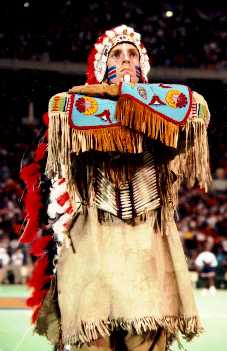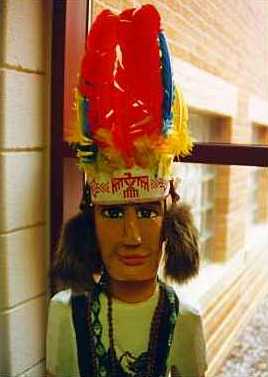Home |
Contents |
Photos |
News |
Reviews |
Store |
Forum |
ICI |
Educators |
Fans |
Contests |
Help |
FAQ |
Info


Wooden Cigar-Store Indians
 The stoic Indian—usually a Plains chief in a feather headdress—supposedly represents the dignity of the "Noble Savage." Maybe so, but it also presents the Indian as bland, personality-free, even soulless—like (the Western view of) an animal. In this form, the Indian appears as wooden as the wood he's usually made of.
The stoic Indian—usually a Plains chief in a feather headdress—supposedly represents the dignity of the "Noble Savage." Maybe so, but it also presents the Indian as bland, personality-free, even soulless—like (the Western view of) an animal. In this form, the Indian appears as wooden as the wood he's usually made of.
A little history
Cigar Store Figures
The Indian "Chief" or "Squaw" suggested a romantic notion of the native based on the novels of James Fenimore Cooper, dime westerns, and other iconographic lore. As the introducer of tobacco to the Europeans the Native American was ubiquitously linked to the industry. Thus a universal brand for tobacco was created.
Cigar Store Figures—Chiefs
The Cigar Store Indian Chief is a figure loaded with contradictions. The image of the Native American suggested divergent mystiques in the mind of the tobacconist's frequenter. First the natives introduced the tobacco plant to the English settlers and therefore remained connected to the product. However, by the late nineteenth century the natives were no longer the actual source of tobacco, which was raised by the labor of blacks and poor whites. Neither did these figures represent laborers anyway. The proud chief, even if he was scouting or hunting, represented a savage correlative to the white gentleman who was the target market. Many of these figures offer cigars by hand, and are thus noble though emasculated servants. The Chief stood on the pavement as an idealized, romantic, and enigmatic Other to attract the white businessman in need of a good smoke.
Cigar Store Figures—Squaws
Squaw figures are at least as ideologically problematic as their male counterparts. These squaws are both savage and gentile (largely due to fact that their sculptors often seem to have had European models in mind). These maidens are sensual yet unrefined. While the chiefs have a hint of femininity in their servility, these female figures assert the relative status of the white male cigar store keeper and patron more more directly.
Cigar Store Figures in America
Today these figures pop out, stick up, and bespeak a commercial culture founded on stereotypes. They remind us that white American solidarity, the melding of ethnicities and nationalities into the uniform category "American," was achieved through leverage both social and economic against people of color.
Wooden Indians still around
People associate the cigar-store statues with small-town main streets from an earlier era, but the stereotype is still with us. For instance, consider the following article:
Subtle racism
Border town businesses stereotype Native Americans
By Milton Bluehouse Jr.
Special to the Navajo Times
February 8, 2001
An example that embodies both outright racism and the cleverness that obscures it are billboards. These large pieces of roadside trash, along hundreds of miles of I-40 in both New Mexico and Arizona, depict Indian people as cartoon caricatures with the stereotypical big nose, red skinned, wearing breach cloths, and brandishing tomahawks.
Travelers are persuaded to "Come and See the Indian Village," as if a Navajo community holds the same entertainment value as a circus freak show. Arrowheads and a glimpse of poorly treated Bison, an animal sacred in Navajo culture, come free with every fill up of a tank of gas. And if these things are not enough, a wooden "chief" or Indian mannequin placed in store front windows of pawn shops, curio stores, and "forts," along with other stuffed animals, stoically stand as if some official Indian greeter.
More stoic Indian examples
Last time I checked, circa 1992, Disneyland had a regular cigar-store Indian on Main Street and a cigar-store Indian bear in its Bear Country. The wooden bear scored double points for the "stoic Indian" stereotype and the "Indian as animal" stereotype. Thankfully, Disneyland eliminated the Indian attack on the log cabin—while a chief on horseback watched the settlers burn, stoically—a while ago.
Below on the left is a third cigar store-type Indian from Disneyland. It's supposedly from the Frontierland Shootin' Exposition, circa 1996. Next to it are more examples of the stoic Indian from the last couple years.



Note the wooden Indian in the picture below. (Treating a headdress as just another fashion accessory is another stereotype.)

The following is a faux wooden Indian from a George Washington High School in Kansas:


More wooden Indians
Roadside America: Cherokee Indian Chiefs
Gallery of Huge Beings
How to protest wooden Indians
Wooden Indian holds sign outside Pizza Schmizza store
* More opinions *
|
|
. . .
|

|
Home |
Contents |
Photos |
News |
Reviews |
Store |
Forum |
ICI |
Educators |
Fans |
Contests |
Help |
FAQ |
Info
All material © copyright its original owners, except where noted.
Original text and pictures © copyright 2007 by Robert Schmidt.
Copyrighted material is posted under the Fair Use provision of the Copyright Act,
which allows copying for nonprofit educational uses including criticism and commentary.
Comments sent to the publisher become the property of Blue Corn Comics
and may be used in other postings without permission.
� The stoic Indian—usually a Plains chief in a feather headdress—supposedly represents the dignity of the "Noble Savage." Maybe so, but it also presents the Indian as bland, personality-free, even soulless—like (the Western view of) an animal. In this form, the Indian appears as wooden as the wood he's usually made of.
The stoic Indian—usually a Plains chief in a feather headdress—supposedly represents the dignity of the "Noble Savage." Maybe so, but it also presents the Indian as bland, personality-free, even soulless—like (the Western view of) an animal. In this form, the Indian appears as wooden as the wood he's usually made of.





